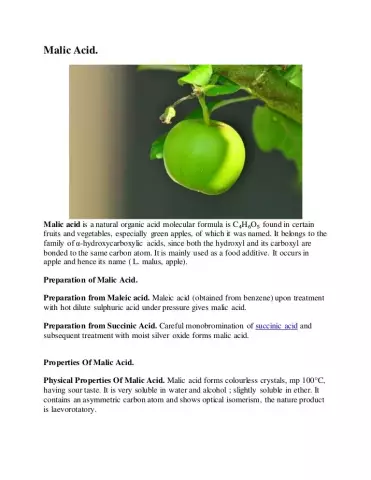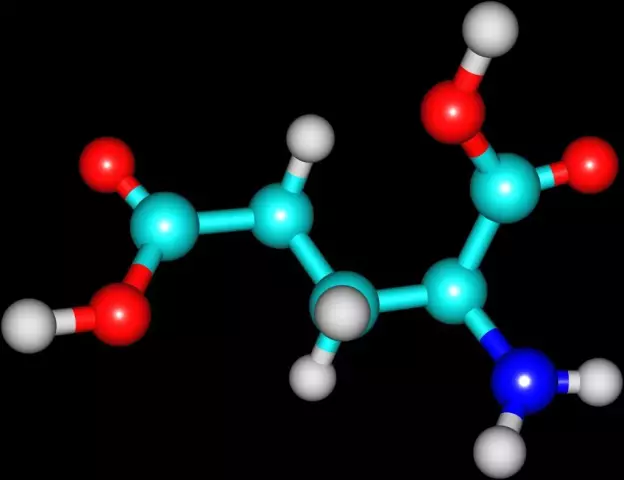- Author Rachel Wainwright [email protected].
- Public 2023-12-15 07:39.
- Last modified 2025-11-02 20:14.
Apple acid

Malic acid is a colorless, hygroscopic crystal that dissolves in water and is thermally affected. For the first time malic acid was obtained in 1785 by the famous Swedish chemist Karl Scheele, who isolated the acid from apples.
Getting malic acid
Malic acid is a food additive labeled as E 296. Crystals of this acid melt at a temperature of 100 degrees, and are of fruit and synthetic origin. The acid is found in apples, gooseberries, grapes, barberries, raspberries, mountain ash, etc.
Malic acid is obtained both naturally, excreted from fruits, and chemically. Also, this acid is found in tobacco as a nicotine salt.
The chemical method for obtaining malic acid is the hydration of maleic acid at a temperature of 170-200 degrees. You can also get malic acid salts called malates.
Malates are beneficial substances for the human body. They promote metabolism, blood circulation and digestion.
Type D malic acid is obtained from tartaric acid and is used as a component in food.
Useful properties and uses of malic acid
The beneficial properties of malic acid are to stimulate metabolism, normalize cell metabolism, improve blood circulation, increase appetite and stabilize digestion, strengthen immunity and enhance the body's protective properties. Also, this acid has anti-inflammatory, decongestant and laxative effects.
An important beneficial property of malic acid is to improve tone in patients with hypertension.
This acid has a positive effect on the cardiovascular system, digestive organs and kidneys.
Malic acid in the form of E 296 food additive is used in the manufacture of canned food, fruit juices, soft drinks, wine and wine drinks, cocktails, confectionery and desserts.

Food additive E 296 is added as a substance to maintain a stable amount of pH in products. This additive acts as an acidity regulator and also gives food and beverages a sour taste.
In winemaking, malic acid is an essential component for imparting the characteristic flavor to wines and wine drinks.
E 296 additive is used in medicine, cosmetology and pharmaceuticals. In pharmacology, this additive improves the absorption of drugs by the body, and also protects red blood cells from the negative effects of chemicals in cancer patients. Malic acid is a component of laxatives, anti-inflammatory and expectorant drugs.
Food additive E 296 is added to cosmetics, hair sprays, shampoos and hair masks, face and body creams, ointments and cosmetic masks. Also in cosmetology, malic acid is used as a component in the composition of products for cleansing and rejuvenating procedures.
Contraindications
Food supplement E 296 is contraindicated for people with high acidity, severe diseases of the digestive system, peptic ulcer disease, cancer, digestive disorders, internal bleeding, as well as in the postoperative period.
Malic acid should be limited in the use of children under 16, as well as women during pregnancy and breastfeeding.
This acid can cause allergic reactions, and when applied to the skin, it exacerbates herpes inflammation and irritation.
Found a mistake in the text? Select it and press Ctrl + Enter.






